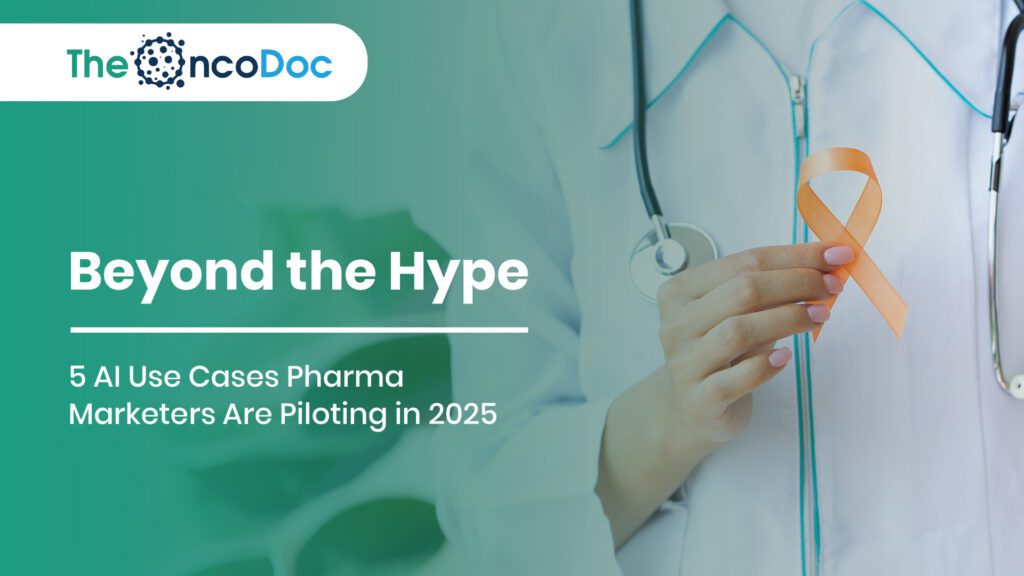Abstract
The pharmaceutical industry, especially within the highly specialized field of oncology in the US, is at an inflection point. The widespread conversation around generative AI, epitomized by large language models like ChatGPT, has brought the potential of artificial intelligence into sharp focus. However, while these tools offer significant promise for content creation, their true transformative power for pharma marketing lies in more sophisticated and integrated applications. This article moves beyond the foundational capabilities of generative AI to explore five critical AI use cases that US pharma marketers are actively piloting and scaling in 2025.
We will analyze how these advanced AI applications are revolutionizing digital marketing in oncology by addressing the unique challenges of engaging with oncologists. The five key use cases include: 1) AI-Driven Predictive Segmentation and Behavioral Profiling; 2) Omnichannel Orchestration for a ‘Segment of One’ Experience; 3) Real-Time Content Personalization and Dynamic Asset Generation; 4) AI-Accelerated Medical, Legal, and Regulatory (MLR) Review; and 5) Intelligent Search and Knowledge Mining from Unstructured Data.
Each use case will be examined in detail, providing a conceptual framework, an overview of the technology, and practical examples relevant to oncology. We will provide data-driven insights and hypothetical models to illustrate the impact of these technologies on marketing effectiveness, resource allocation, and, ultimately, the quality of scientific exchange. This article is designed to be an educational guide for pharma managers and their teams, offering a clear roadmap for leveraging AI to create more valuable, compliant, and impactful engagement with oncologists and other healthcare professionals in the US.
Introduction: From Experiment to Enterprise-Wide AI
For many in the pharmaceutical industry, 2024 was the year of AI exploration. Spurred by the public debut of tools like ChatGPT, marketing teams began to experiment with generative AI for tasks ranging from drafting social media posts to summarizing scientific abstracts. This initial wave of adoption was valuable, but it barely scratched the surface of AI’s full potential. The true revolution in pharma marketing isn’t about automating a single task; it’s about fundamentally rethinking and rebuilding the entire engagement ecosystem around an intelligent, data-driven core.
In 2025, the focus has shifted from simple experimentation to strategic, enterprise-wide implementation. The US oncology market, with its high-stakes, data-intensive, and rapidly changing landscape, is a key proving ground for these advanced AI applications. Oncologists are discerning, time-poor, and demand highly relevant, evidence-based information. Generic, mass-market approaches are failing to capture their attention, leading to declining engagement rates and a sub-optimal dissemination of life-saving information.
This article will demonstrate that the most forward-thinking pharma companies are no longer just asking “Can AI write a good email?” but “How can AI build a personalized, coherent, and highly valuable engagement journey for every single oncologist?” The answer lies in the strategic piloting of the five use cases we’ll explore. These applications are moving beyond basic generative functions to tackle the most complex and critical challenges in modern pharma marketing, leveraging the full spectrum of AI technologies to create a new paradigm of intelligent, respectful, and effective engagement.
Case 1: AI-Driven Predictive Segmentation and Behavioral Profiling
The Problem
Traditional marketing segmentation relies on static, demographic, or firmographic data (e.g., oncologist specialty, geographic location, practice size). This provides a broad-brush view but fails to capture the dynamic, individual preferences and needs of each oncologist. A thoracic oncologist’s interests can shift from new NSCLC therapies to rare sarcomas, and their preferred channels for information may change based on their daily schedule. Mass-market campaigns based on static segments inevitably lead to a high volume of irrelevant communications, eroding engagement and trust.
The AI Solution
AI-driven predictive segmentation uses machine learning to analyze a vast array of behavioral data points, creating a dynamic, “segment of one” profile for each healthcare professional. This process goes beyond simple categorization to predict future behaviors and informational needs.
- Data Inputs: The AI model ingests data from multiple sources:
- Internal: CRM data, website clicks, content downloads, virtual event attendance, search queries on company portals.
- External: Publicly available information on scientific publications, clinical trial involvement, professional society memberships, and social media engagement (where ethically and compliantly sourced).
- Predictive Modeling: The AI identifies hidden correlations and patterns in this data that a human could never find. For example, it might discover that oncologists who spend more than 5 minutes on a specific clinical trial summary page and then click on a link to a related patient support program are highly likely to be open to a follow-up conversation with a medical science liaison (MSL).
Practical Application in Oncology
A pharma company can use AI to build a “Digital Oncologist Profile.”
- Predictive Persona: Instead of a generic “academic oncologist,” the AI creates a profile of a “Dr. Smith, a GI oncologist at a large academic center, with a high propensity for engaging with novel biomarker-driven therapies, prefers on-demand video content for clinical trial summaries, and is most active on professional networking sites on Sunday evenings.”
- Proactive Outreach: When a new paper is published on a novel therapy for a specific GI cancer, the AI can trigger an alert, recommending to the marketing team to deliver a 90-second video abstract of the paper to Dr. Smith’s preferred platform at his predicted time of peak activity.
- Quantifiable Impact: This approach leads to higher content open rates, click-through rates, and a measurable increase in valuable interactions with medical and sales teams.

Case 2: Omnichannel Orchestration for a ‘Segment of One’ Experience
The Problem
Despite the rise of digital channels, pharma marketing often remains siloed. An oncologist might receive an email about a new therapy, see an ad on a professional website for the same drug, and then get a visit from a sales rep who is unaware of their prior digital engagement. This creates a disjointed and often frustrating experience for the HCP, leading to a perception of disorganization and a waste of their time.
The AI Solution
AI acts as a central brain, orchestrating a seamless, personalized journey across all touchpoints, whether digital or human. This is known as “optichannel” marketing—optimizing the channel based on individual behavior, not just a pre-defined plan.
- Journey Intelligence: AI tracks the oncologist’s interactions across every channel, from web page views to webinar attendance and rep interactions. It synthesizes this data in real time to understand the oncologist’s current “state” in their learning journey.
- Next Best Action (NBA) Recommendation: Based on this real-time intelligence, the AI recommends the next most valuable action. This could be a personalized email, a push notification for a new clinical abstract, or a prompt for a sales rep to reach out with specific, highly relevant talking points.
Practical Application in Oncology
- Coordinated Campaigns: An oncologist views a white paper on a company’s website about a new targeted therapy. The AI recognizes this intent signal and, instead of a generic email blast, it suppresses a planned mass email and instead sends a personalized invitation to a targeted webinar with a KOL on the same topic.
- Empowering Sales and Medical Teams: The AI can brief a sales rep or MSL with real-time insights before a meeting, providing them with a “cheat sheet” of the oncologist’s recent digital interactions, preferred topics, and engagement level. This transforms the conversation from a generic pitch to a highly relevant and valuable scientific exchange.
- Quantifiable Impact: This approach significantly improves the efficiency of both digital spend and human resources, leading to a higher return on investment (ROI) for engagement efforts.

Case 3: AI-Accelerated Medical, Legal, and Regulatory (MLR) Review
The Problem
The US pharmaceutical industry operates under some of the most stringent regulatory environments in the world. The review and approval process for all marketing and medical communications—the MLR review—is a critical but often lengthy bottleneck. This can delay the dissemination of urgent scientific information and slow down a brand’s ability to react to real-time market needs. The manual nature of the review process is time-consuming and prone to human error.
The AI Solution
AI is being used to automate and accelerate parts of the MLR process, enabling faster and more compliant content creation and deployment.
- Pre-submission Screening: AI models, trained on a company’s vast library of previously approved content, can act as a “first line of defense.” They can check new content against a repository of approved claims, references, and disclaimers. The AI can instantly flag potential compliance risks, unapproved phrases, or missing citations before a human reviewer even sees the document.
- Compliance Automation: Generative AI, fine-tuned on approved content, can automatically produce on-brand, compliant text and visuals. For example, a marketer could ask a trained AI model to “create a 100-word summary of the Phase 3 trial results for Drug X for social media, referencing the approved data,” and the AI would generate a draft that is pre-vetted for compliance.
Practical Application in Oncology
- Rapid Response to Data Drops: When new data from a major oncology conference (e.g., ASCO) is released, a pharma company needs to get compliant communication to oncologists quickly. AI can drastically reduce the MLR review time, allowing for near-real-time updates on key data points.
- Risk Reduction: By automatically catching a majority of potential compliance issues, AI reduces the burden on human legal and regulatory teams, allowing them to focus on the most complex and nuanced cases. This leads to fewer compliance violations and a faster go-to-market for critical information.
- Quantifiable Impact: AI-accelerated MLR can reduce content approval times from several weeks to just a few days, giving a brand a significant competitive advantage in the fast-paced oncology market.

Case 4: Intelligent Search and Knowledge Mining from Unstructured Data
The Problem
Oncologists and MSLs are drowning in unstructured data. Scientific literature, conference proceedings, internal clinical data, and even digital communication are filled with valuable, but difficult-to-access, information. Finding a specific data point, a rare adverse event from a study, or a particular patient sub-group mentioned in an expert’s presentation can be a manual and time-consuming process.
The AI Solution
AI, particularly with advanced Natural Language Processing (NLP), can act as an intelligent “knowledge mining” tool, extracting, organizing, and summarizing information from vast, unstructured datasets.
- Semantic Search: Unlike traditional keyword-based searches, AI-powered semantic search understands the context and meaning of a query. An oncologist can ask a question in natural language (e.g., “What is the long-term survival data for Drug A in patients with Stage III pancreatic cancer with a KRAS G12D mutation?”) and the AI will scan a massive database of clinical trial reports, journal articles, and internal data to provide a concise, evidence-based answer with sources.
- Insight Generation: NLP can analyze millions of documents to identify emerging trends, unmet needs, or common questions from oncologists. This can inform future content strategy and guide the focus of clinical and medical teams.
Practical Application in Oncology
- Empowering MSLs: An MSL can use an AI-powered tool to instantly access and synthesize the latest scientific data, helping them answer complex, on-the-spot questions from oncologists with a level of detail and accuracy that was previously impossible without a lengthy manual search.
- Market Intelligence: Pharma can use AI to analyze transcripts of medical forums, virtual meetings, and market research to understand the most pressing clinical questions and emerging topics of interest among oncologists, allowing them to proactively create valuable content.
- Quantifiable Impact: This use case reduces the time spent on manual research by up to 70%, increases the quality of scientific dialogue, and empowers teams to be more responsive to the needs of the oncology community.

Case 5: Real-Time Content Personalization and Dynamic Asset Generation
The Problem
In the modern digital landscape, content quickly becomes stale. The static nature of traditional marketing assets—a fixed web page, a static PDF—fails to adapt to a user’s real-time behavior. An oncologist’s interests may evolve during a single session on a company’s website. Pushing a generic, pre-defined asset misses the opportunity to provide a truly personalized and relevant experience.
The AI Solution
AI enables real-time content personalization, allowing web pages and digital assets to dynamically change based on a user’s behavior. This means a single asset can have hundreds of variations, all automatically generated and delivered.
- Dynamic Landing Pages: AI can analyze a user’s IP address, referral source, and click history on the fly to change the content and visuals on a landing page. An oncologist clicking from a clinical trial database will see different content and calls-to-action than an oncologist clicking from a general medical news site.
- Generative Asset Creation: AI can create multiple versions of an asset (e.g., an email subject line, a short video clip) and test them in real time to see which one performs best with a specific segment. It learns from these interactions and optimizes future deliveries.
Practical Application in Oncology
- Personalized Website Experience: A visiting oncologist who is a known expert in CAR-T therapy might land on a homepage that dynamically highlights the company’s research pipeline in cell therapies, rather than a generic overview of all its oncology products.
- Tailored Email Communications: An AI can a/b test hundreds of email subject lines and content variations to determine which one is most likely to be opened and engaged with by a specific type of oncologist, automatically rolling out the winning version.
- Quantifiable Impact: This leads to a measurable increase in engagement metrics, from higher open rates and click-through rates to a deeper time spent on site and a greater likelihood of a conversion.

Conclusion: A New Era of Intelligent Engagement
The US oncology market, with its complexity and importance, is a key driver of pharmaceutical innovation. While the public’s fascination with tools like ChatGPT has opened the door to AI, the real revolution for pharma marketers is happening in more sophisticated use cases. The five applications outlined in this article, predictive segmentation, omnichannel orchestration, AI-accelerated MLR, intelligent knowledge mining, and real-time content personalization, represent the new frontier of engagement.
These AI-driven strategies empower pharma managers to move beyond broadcasting generic messages to building meaningful, data-driven relationships with oncologists. By leveraging AI to understand, anticipate, and respond to the unique needs of each healthcare professional, companies can deliver an experience that is not only more effective but also more valuable and respectful of the oncologist’s time. This is no longer just about marketing a product; it is about facilitating a seamless, intelligent, and ongoing scientific exchange that ultimately contributes to better clinical decision-making and improved patient outcomes. For those ready to lead, the future of pharma marketing is already here, and it’s powered by AI.
The Oncodoc team is a group of passionate healthcare and marketing professionals dedicated to delivering accurate, engaging, and impactful content. With expertise across medical research, digital strategy, and clinical communication, the team focuses on empowering healthcare professionals and patients alike. Through evidence-based insights and innovative storytelling, Hidoc aims to bridge the gap between medicine and digital engagement, promoting wellness and informed decision-making.



